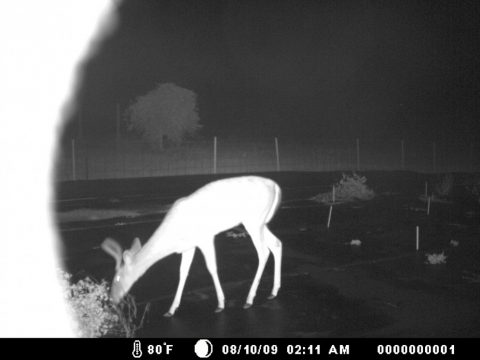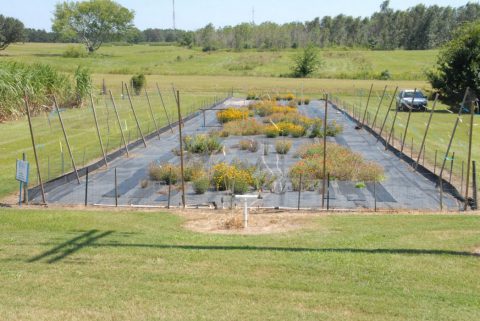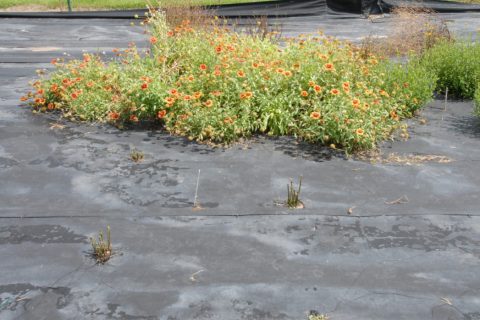Nature’s salad bar: Deer have a taste for wildflowers
by Dr. Jeff Norcini
Have you ever had a deer wander into your yard to dine on your landscape plants? Well, that’s what happened several years ago at a wildflower demonstration garden established as part of my extension program at the University of Florida/IFAS research center in Quincy.
We observed that deer, which can be quite abundant in northern Gadsden County (Quality Deer Management Association), found Florida tickseed (Coreopsis floridana) and Swamp tickseed (Coreopsis nudata) quite to their liking amongst 14 native wildflowers and one native grass. They liked Stokes’ aster (Stokesia laevis), too. How did we know it was deer and not rabbits eating the plants? To prevent browsing, we had to surround each plant with chicken wire. Deer tracks helped identify the culprits, too!
These observations led to a full-blown scientific study in 2008 and 2009 about deer wildflower-browsing preferences. The study, which was recently published, was a team effort at the Quincy research center involving the departments of Wildlife Ecology (Holly Ober, Luke DeGroote) and Environmental Horticulture (Jim Aldrich, Gary Knox, and myself). Deer browsing plots were established each year using containerized plants of 11 wildflower species, all Asteraceae: Goldenmane tickseed (Coreopsis basalis), Florida tickseed (Coreopsis floridana), Coastalplain tickseed (Coreopsis gladiata), Fringeleaf or Chipola tickseed (Coreopsis integrifolia), Lanceleaf tickseed (Coreopsis lanceolata), Leavenworth’s tickseed (Coreopsis leavenworthii), Blanketflower (Gaillardia pulchella), Pinnate prairie coneflower (Ratibida pinnata), Orange coneflower (Rudbeckia fulgida), Black-eyed Susan (Rudbeckia hirta), and Softhair coneflower (Rudbeckia mollis). (Swamp tickseed was not included in the study because no seed or plants were available.) A tall fence around each plot protected 38 percent of the plants from deer. Deer damage was assessed every two weeks both years from April to November.
The heaviest deer-browsing occurred from mid-summer to fall, although the intensity of browsing over time varied between years and amongst wildflower species. Deer clearly preferred Florida tickseed, Coastalplain tickseed, Fringeleaf tickseed and Orange coneflower (the percentage of plants browsed was 67, 60, 48, and 42 percent, respectively). Browsing reduced flowering of Florida and Fringeleaf tickseed by at least 50 percent, and eventually killed a significant number of these plants. Interestingly, deer-browsing did not affect flowering of coastalplain tickseed, which flowers at the same time as Florida tickseed, strongly resembles Florida tickseed, and is much more common than Florida tickseed in the Panhandle. Orange coneflower, despite heavy browsing by deer, showed no ill effects in terms of growth or flowering.
The other seven species were browsed to some degree, with the percentage of browsed plants ranging from 27 percent (Leavenworth’s tickseed) to 5 percent or less (Blanketflower, Pinnate prairie coneflower, Lanceleaf tickseed, Goldenmane tickseed). Lack of preference for Goldenmane tickseed was a bit surprising as cattle like to graze on it (Terry Zinn, personal communication).
So, what’s this mean to you? First, because none of the wildflowers were immune to browsing, if you live in an area with a lot of deer, don’t be surprised if any of these wildflowers are nibbled. Second, if you have one of the heavily browsed species in your landscape and deer find it, expect repeat visits, because deer have good memories about food sources. Moreover, you’ll need to protect those plants in some manner, except for Orange coneflower. If you are a hunter and want to include wildflowers to attract deer to a food plot, use Orange coneflower. Of the four most heavily browsed wildflowers, it’s the only one that’s clearly sustainable.
Details of this study are published in the Volume 4, 2011 issue of the journal Southeastern Naturalist: DeGroote, L.W., H.K. Ober, J.H. Aldrich, J.G. Norcini, and G.W. Knox. 2011. Susceptibility of cultivated native wildflowers to deer damage. Southeastern Naturalist 10(4):761-771. The senior author, Luke DeGroote, can be contacted at degroote.1@gmail.com.



